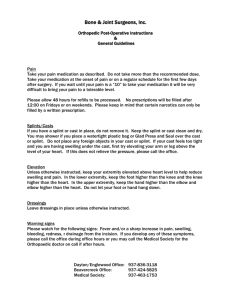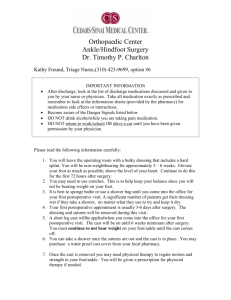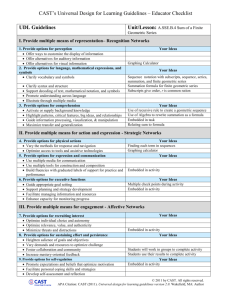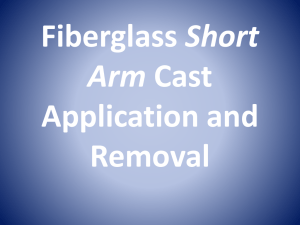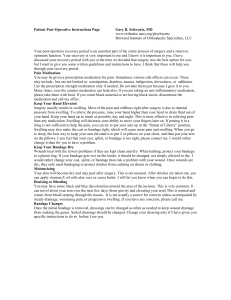Cast Care Instructions
advertisement
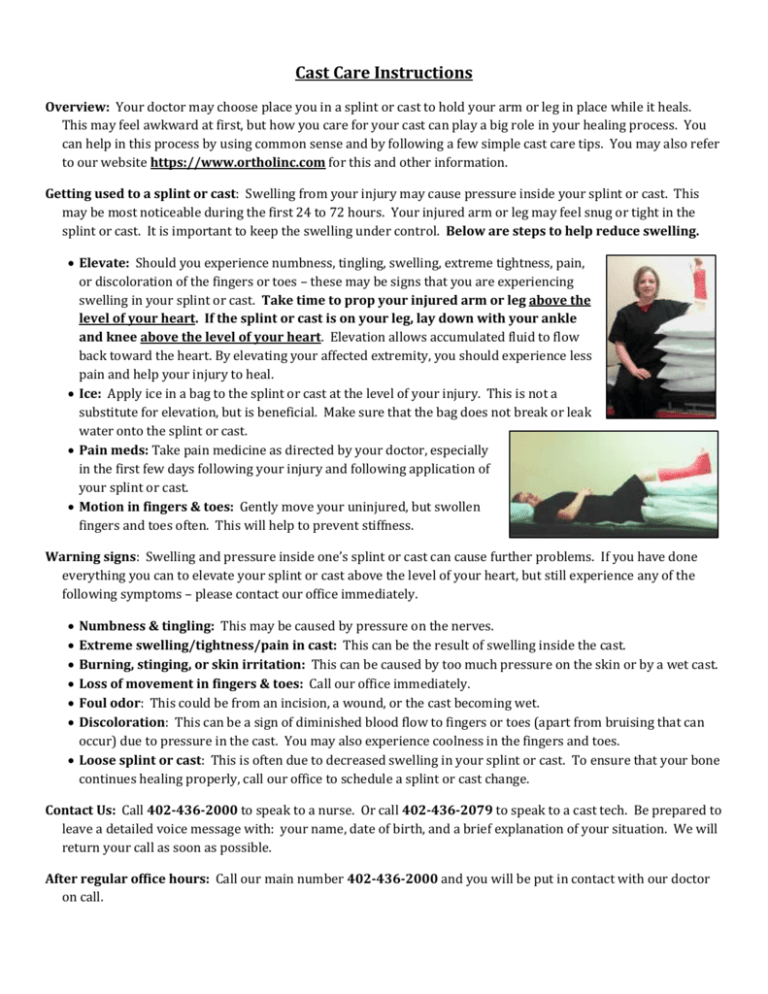
Cast Care Instructions Overview: Your doctor may choose place you in a splint or cast to hold your arm or leg in place while it heals. This may feel awkward at first, but how you care for your cast can play a big role in your healing process. You can help in this process by using common sense and by following a few simple cast care tips. You may also refer to our website https://www.ortholinc.com for this and other information. Getting used to a splint or cast: Swelling from your injury may cause pressure inside your splint or cast. This may be most noticeable during the first 24 to 72 hours. Your injured arm or leg may feel snug or tight in the splint or cast. It is important to keep the swelling under control. Below are steps to help reduce swelling. Elevate: Should you experience numbness, tingling, swelling, extreme tightness, pain, or discoloration of the fingers or toes – these may be signs that you are experiencing swelling in your splint or cast. Take time to prop your injured arm or leg above the level of your heart. If the splint or cast is on your leg, lay down with your ankle and knee above the level of your heart. Elevation allows accumulated fluid to flow back toward the heart. By elevating your affected extremity, you should experience less pain and help your injury to heal. Ice: Apply ice in a bag to the splint or cast at the level of your injury. This is not a substitute for elevation, but is beneficial. Make sure that the bag does not break or leak water onto the splint or cast. Pain meds: Take pain medicine as directed by your doctor, especially in the first few days following your injury and following application of your splint or cast. Motion in fingers & toes: Gently move your uninjured, but swollen fingers and toes often. This will help to prevent stiffness. Warning signs: Swelling and pressure inside one’s splint or cast can cause further problems. If you have done everything you can to elevate your splint or cast above the level of your heart, but still experience any of the following symptoms – please contact our office immediately. Numbness & tingling: This may be caused by pressure on the nerves. Extreme swelling/tightness/pain in cast: This can be the result of swelling inside the cast. Burning, stinging, or skin irritation: This can be caused by too much pressure on the skin or by a wet cast. Loss of movement in fingers & toes: Call our office immediately. Foul odor: This could be from an incision, a wound, or the cast becoming wet. Discoloration: This can be a sign of diminished blood flow to fingers or toes (apart from bruising that can occur) due to pressure in the cast. You may also experience coolness in the fingers and toes. Loose splint or cast: This is often due to decreased swelling in your splint or cast. To ensure that your bone continues healing properly, call our office to schedule a splint or cast change. Contact Us: Call 402-436-2000 to speak to a nurse. Or call 402-436-2079 to speak to a cast tech. Be prepared to leave a detailed voice message with: your name, date of birth, and a brief explanation of your situation. We will return your call as soon as possible. After regular office hours: Call our main number 402-436-2000 and you will be put in contact with our doctor on call. Taking Care of Your Splint or Cast: Your doctor may explain certain restrictions or instructions for use of your arm or leg in a cast. Please follow their advice to ensure proper healing of your injury. Keep Dry: This is very important! Moisture weakens your cast and can cause the cast padding to hold that moisture (water, sweat, etc.) next to your skin. This in turn causes the skin to turn white and “wrinkly” and begin to breakdown. You may also experience a burning sensation and notice a musty smell from the cast. For Bathing: Bag: Use two layers of heavy duty bags with tape and rubber bands above the top edge of cast to keep the cast dry. (You can also purchase reusable shower bags at places like Jim’s Home Health, Doak’s Training Room, or See the Trainer.) Check: Keep the bag on until you are completely dry, and then check the cast. Blow Air: Should the cast be slightly damp, use a hair dryer on cool setting only to blow air into the cast (CAUTION: WARM SETTINGS MAY CAUSE SKIN TO BURN). If you are unable to dry out the splint or cast, call our office immediately. No Submerging: Do not submerge the cast, even if covered, as the bag often fails to keep water out. No Walking on Bag: With leg splints or casts, do not stand on bag as this may cause a hole in the bag. Do Not Use Powders in splints or casts to dry out moisture or to treat itching symptoms. Keep Clean: Keep dirt, sand, powders or lotions away from the inside of your splint or cast to prevent skin irritation. Wash fingers and toes with rubbing alcohol or sanitizing liquid, while keeping splint or cast dry. Itching: Your skin can become sensitive in a splint or cast. Scratching inside the cast could cause skin irritation, open sores, and even permanent scarring. This can also cause your splint or cast to fit poorly. Do not stick any objects, including your finger, down the cast to itch. Do not use powders or lotion in the splint or cast. You can blow cool air into the splint or cast to dry it out, as sweat can often be the cause of the itching. Skin: Check the skin around the edges of the splint or cast. If your skin becomes red or tender around the edges of your splint or cast, contact our office immediately. Don’t Mess With Padding: This allows for comfort in your splint or cast, while accommodating to swelling. Do not pull out the padding or stockinette from splint or cast. This may cause the cast to fit improperly or cause an abrasion from the cast rubbing against your skin. Do not add padding. If your cast is loose, rather than adding padding – call for a cast change. This will help to ensure proper healing. Your splint or cast MAY BECOME LOOSE before your follow-up appointment. This is often due to decreased swelling in your splint or cast. Call our office to schedule a splint or cast change. Check Cast Regularly: If your cast becomes cracked or develops soft spots, contact our office. If caught early, your splint or cast could be fixed without having to make a new one. Trimming or Removing Cast: DO NOT REMOVE YOUR CAST. If you are wearing a splint, your doctor may give you specific instructions for taking your splint off. You can use a nail file to smooth out rough areas on the cast. Do not break off rough edges of your cast. Cast Shoes: If you are in a short leg walking cast and have been fitted for a cast shoe, always wear the cast shoe when weight bearing to prevent your cast from breaking in the heel or near the toes. Arm Slings: Take your arm out of the sling regularly unless directed otherwise by your doctor. Cast Removal: Again, DO NOT REMOVE THE CAST YOURSELF - you may cut your skin or prevent proper healing of your bone. Call our office if you feel like your cast is loose or needs to be changed. Should your doctor want to remove the cast at your follow-up appointment, a cast saw with a vibrating blade will be used. Cast saws are noisy and cause warmth from friction, but will not harm you or cut your skin.
